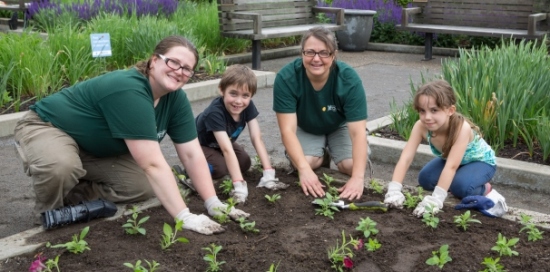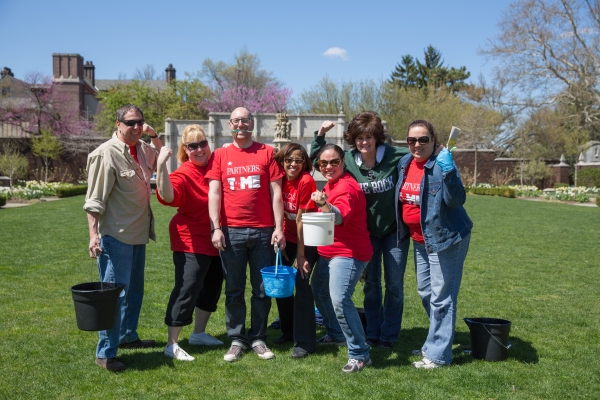Believe it or not, staff at the Pittsburgh Parks Conservancy do not hibernate during the winter.

Angela, Jaci, and Jake taking care of a tree in Highland Park
While some of us cozy up in the office with woolly sweaters and Big Gulp-sized mugs of coffee and tea, there are those of us that are out in the parks in any weather. Two such dauntlessly awesome staffers are our horticulturist Angela and our gardener Jaci. Regularly spotted outside in ultra heavy duty winter wear, they recently visited the office clad in all-weather work boots carrying a box of treasures — seeds and buds and clippings from plants around the parks. These finds, hidden in the drab colors of winter, were an unusual learning experience and a fun way to study the parks in winter.
If you’re a regular reader of our blog/social media, you might have caught our Know Your Native or What’s In Bloom segments. During the growing seasons, Angela compiles pictures of blossoms and buds from the park gardens for her monthly What’s in Bloom series. Our more sporadic Know Your Native highlights local plants that staffers find and photograph around the parks.
This week, we’re meshing the two. And adding a fun mnemonic twist. We’re also bending the rules; technically, none of these finds are currently in bloom. And a couple of them aren’t natives, but we’re throwing them in, too. Let’s get started! (Note: Information about these plants came from the great Missouri Botanical Garden.)
Tulip (Liriodendron tulipifera)

A large deciduous tree native of eastern North America, the tulip tree, otherwise known as the yellow poplar, is easily identified by its tulip-shaped flowers seen here. The flowers can be tough to spot in spring since they bloom after the tree’s leaves pop open. Its genus name comes from Greek leirion (lily) and dendron (tree). Tulipifera means tulip bearing.
Fun fact: Native Americans made dugout canoes from tuliptree trunks. Source.
Horse chestnut (Aesculus hippocastanum)

Tripping over the large spiked fruits that we think look like boot spurs is an easy way to identify the invasive horse chestnut, or conker tree. When the skin of the fruit breaks, you can find one or two dark brown horsechestnuts, a relative of the buckeye (but not the chestnut), inside. Check back with these trees in the spring when they show off white, red and yellow flowers.
Fun fact: The alternate name for this tree, conker tree, comes from a British-Irish children’s game that dates back to the 1800s. For this “game,” children would tie strings to the spiked fruits and bop each other over the head until the fruit broke. We’re not sure if you win when the fruit breaks…? Don’t try that at home.
Goldenrain (Tree Sapindaceae)

In the winter, you can identify the invasive goldenrain tree by the papery seed capsules that are a bit reminiscent of Chinese lanterns. The tree blossoms in early summer with flowers of varying shades of yellow, which make a golden yellow carpet under the tree. This tree is air pollution resistant, helping it thrive in urban areas.
Eastern beech (Fagus sylvatica)


The European beech has been a popular ornamental tree in the United States since the mid-1700s. The trunk has a distinctive smooth, gray texture that seems to fold and melt around branches. Leaves of the beech tree aren’t abscissed in fall, meaning they hold on to their leaves all winter. Female flowers give way to two triangular nuts held in spiny capsules, seen here:
Sweet gum (Liquidambar styraciflua)

A native to eastern North america, no doubt you’ve noticed the sweet gum’s signature ‘gumballs’ spread out at the base of these trees. These spiky globular fruiting clusters are the product of female flower. The name of this tree comes from the sweet-smelling ‘gum’ that the tree exudes when cut.
Fun fact: The tree’s gum has indeed been used for chewing gum. It’s also been used to make incense, perfumes, folk medicines and flavorings.
Carolina silverbell (Halesia carolina)

Identifying this native tree is a bit of a gimme. Shown here are the nut-like fruits that cluster like bells. Watch in April when the trees flowers start to bloom in even more obvious bell shapes. Like a bell rung for dinner, these gorgeous flowers seem to bring in warmer weather.
Like to learn more about what makes up our park flora? Follow us on Twitter or Facebook to catch our Know Your Native features, or subscribe to our blog at the bottom right corner. And if you haven’t picked up a copy of our gorgeous Invasive Plants of Pittsburgh guidebook, order one today!
Lauryn Stalter for the Pittsburgh Parks Conservancy

We just have to throw in one more, because we can’t resist. We’ll leave you with Staphylea trifolia, otherwise known as bladdernut. While not the most attractive name, this native does show some pretty flowers in spring!
This blog was originally posted in February 2014.























